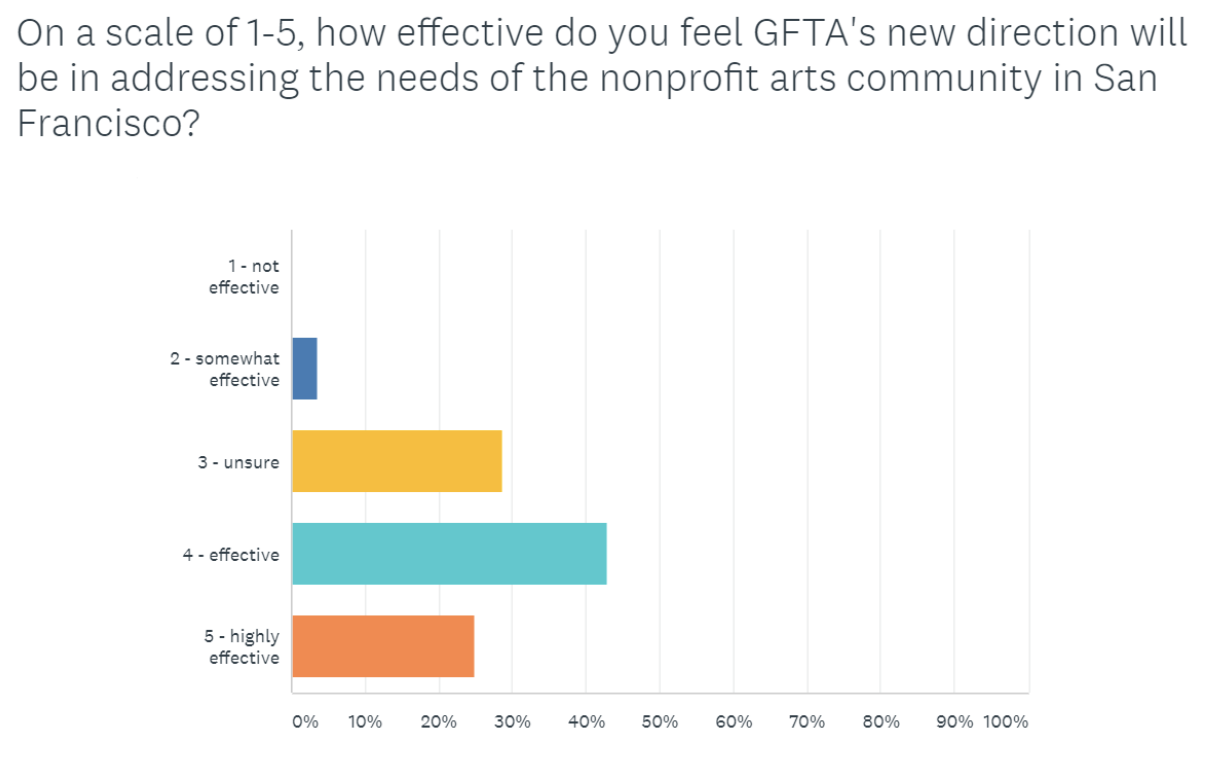I. OVERVIEW / METHODOLOGY
In February 2020, Grants for the Arts (GFTA) began to re-evaluate its mission and priorities as an agency. Through this evaluation, the staff derived a vision, a set of values and goals, and edited the mission statement, centering equity as the principle component of its work. The staff briefed its Advisory Panel on the visioning work in July, and the panel’s recommendations were incorporated in the work over the following weeks.
In September 2020, GFTA engaged its community (current grantees and applicants, key external stakeholders, and City colleagues) to elicit feedback on the agency’s visioning work, grantmaking process, and general needs in San Francisco’s nonprofit arts sector.
GFTA staff conducted nine community listening sessions, totaling 13.5 hours with 92 registered participants, and interviewed 28 individuals, totaling over 14 hours. All current grantees and Fiscal Year 2021 applicants were invited to participate in the community listening sessions, with one session reserved for Cultural Centers’ and Cultural Districts’ leadership staffs. Below is the list of the internal and external stakeholders who took part in the individual interviews:
|
Internal Stakeholders:
External Stakeholders:
|
In addition to the community listening sessions and individual interviews, staff created a pre-work questionnaire and a post-survey for participants to complete. The questions varied slightly between community listening session participants and interviewees. Below are the questions asked on the questionnaire and survey:
Back to topPre-Work:
|
Listening Sessions
Interviews
|
Post-Survey:
|
Listening Sessions
Interviews
|
After the collection of data, the staff synthesized the findings from the listening sessions, interviews, questionnaires, and surveys. Those data points were then incorporated into the final draft of the agency’s mission, vision, values, and goals. Highlights of this visioning work includes: incorporating the importance of diverse communities of San Francisco and equitable grantmaking into the agency’s mission, creation of a vision statement, centering equity as the its principal value, and developing long-term goals that allow the agency to fulfill its values.
When it is completed, GFTA will incorporate the City Administrator’s Office’s racial equity plan into its goals and objectives. Staff also intends to better define other types of equity within their grantmaking, such as gender, sexual orientation, geography, etc.
In addition to the visioning findings, this assessment generated key insight into the community’s understanding of GFTA’s values (see Appendix), the grantmaking process, and other needs of the arts sector.
Back to topII. VISIONING WORK
Back to topMISSION
At Grants for the Arts (GFTA), our mission is to promote the diverse and unique communities of San Francisco by supporting the arts through equitable grantmaking.
Back to topVISION
To uplift San Francisco nonprofit arts and cultural organizations in a manner that ensures equitable access to GFTA resources; to fully recognize their humanity and that of the communities they serve, exemplifying the value of their contributions to our city; to provide the opportunity to enrich and enhance the arts ecosystem of San Francisco to all; and to identify and eliminate barriers in our grantmaking, enabling arts organizations to prosper and reach their full potential.
Back to topVALUES
GFTA embraces EQUITY as our principal value.
EQUITY entails a commitment to ensuring GFTA’s grants and resources are accessible to all, understanding that certain communities have been historically overserved due to systemic advantages and access. Recognizing that arts organizations have not received equitable resources due to race, geography, and other marginalizing factors, GFTA endeavors to bolster culturally diverse and geographically-dispersed organizations by eliminating obstacles and shortfalls in grantmaking that have prevented the full participation, success, and stability of applicants and grantees.
In addition to EQUITY, three core values guide our work:
- VIBRANCY
- ACCOUNTABILITY
- TRANSPARENCY
VIBRANCY comprises the unique contributions grantee organizations bring to the arts landscape of San Francisco, steeped in the city’s values of diversity, inclusion, innovation, engagement, risktaking, and adaptability; evidenced by lively, imaginative programming, artistic cultivation, community relevance, a welcoming and safe atmosphere, preservation of marginalized spaces, local community and visitor interest and engagement, audience impact, demonstrable commitment to continued improvement, and management of artistic risk.
ACCOUNTABILITY requires holding both the agency and its grantees to the highest standard of integrity, ensuring that public funds are distributed and used in accordance with their intended purpose. It also requires GFTA to recognize our position of leadership in supporting the needs of the field, while adhering to the policies, procedures, and stakeholders of the City and County of San Francisco, with the understanding that community engagement is integral to our process.
TRANSPARENCY stems from cultivating a trust-based relationship between the agency and its stakeholders, which include City officials, Advisory Panel members, current grantees, future applicants, and the general public, with consistent, straightforward, and open communication regarding GFTA’s programs, policies, and procedures.
Back to topGOALS
GFTA’s work, procedures, and purpose will adhere to the values of EQUITY, VIBRANCY, ACCOUNTABLITY, and TRANSPARENCY in our grantmaking practices by:
- Committing to EQUITY in every aspect of our grantmaking, actively working to dismantle practices that have historically advantaged particular groups, and to more deeply support arts organizations within communities that have been harmed by a lack of access and resources;
- Enriching and promoting the VIBRANCY of San Francisco’s arts and cultural communities for the benefit of residents and visitors through equitable funding;
- Remaining ACCOUNTABLE to the needs of applicants and grantees through intentional, antiracist grantmaking, and providing resources that will foster grantees’ accountability to their own communities; and
- Ensuring TRANSPARENCY through continued engagement, producing clearly defined grant programs and funding practices, making this information easily accessible to the public.
III. GRANTMAKING STRATEGIES
In addition to the visioning work, GFTA engaged its community of grantees and applicants on potential adjustments to grantmaking practices to better align with the agency’s equity goals. GFTA staff proposed four strategies that would emphasize equity in the agency’s general operating support program. The four proposed strategies are:
- Treating returning grantees and new applicants alike;
- Prioritizing communities served and collaborations and partnerships in the narrative section of the application;
- Focusing on organizations deeply rooted in their communities and prioritizing them for support;
- Utilizing the scorecard as a tool for funding.
Historically, GFTA has prioritized funding returning grantees over new applicants, and the agency has been seen as a stable source of support for returning grantees year after year. In recent years, new applicants have increasingly served, been led by, or resided in BIPOC communities or San Francisco neighborhoods where GFTA has historically provided little support. Also, in Fiscal Year 2021, the agency deployed a pilot scorecard for evaluating all applicants and found that new applicants who received awards scored higher on average than returning grantees. The community has expressed that treating new and returning applicants alike would generally be a significant step towards equitable access to funding, but many questioned what the specific impact would be for their organizations.
During the process, concerns arose around several topics including the eligibility requirements for new applicants and returning grantees being the same, the dependability of GFTA funding one year to the next, the historical precedent of returning organizations that are currently experiencing a decline in audience and programming continuing to be funded, and how these funding decisions impact BIPOC-led and serving organizations that have just recently been added to the docket.
On the pilot scorecard used in Fiscal Year 2021, the combined scores for the Communities Served and Collaborations and Partnerships narrative questions totaled 30 out of 100 points. To underscore GFTA’s commitment to 1) supporting diverse, historically marginalized communities and 2) collaborating and sharing resources, the staff and Advisory Panel proposed to increase the total points that can be awarded in these categories to 25 points each. This means half of the points awarded will derive from these two sections, a total of 50 points. The remaining 50 points will be divided between Quality of Programming, Budget, Governance, Space & Strategic Planning, and Economic Impact.
The surveyed community saw value in audience outreach, responsiveness to community needs, and support for arts groups residing in or engaging with BIPOC and geographically underserved communities. Acknowledging the limited resources available to the arts, participants recognized that collaboration and partnership amongst themselves and other entities, both in the private and public sectors, are integral to their success, and suggested increased support for those organizations that are leveraging their networks most effectively. This proposal sparked further conversations around peer-learning cohorts and mentorships, resources for diversity and audience development training, and an arts resource hub.
To support prioritizing deeply rooted organizations and cultural anchors, staff spent a significant amount of time exploring characteristics of organizations that are deeply rooted in their communities with participants. Characteristics frequently mentioned were: of/by/for their community, legacy, authentic impact and engagement, relevance, cultural preservation, culturally competent, deep scale expertise, strong connection to San Francisco, resides in their community, the community they serve is central to their mission, empowers their community, and resilience. These characteristics will help serve as a guide for GFTA identifying organizations that are deeply rooted in their communities with the intention of adding a question about being deeply rooted to the application and embedding these characteristics into the narrative evaluation criteria. The community was in broad consensus that uplifting deeply rooted organizations and cultural anchors is important to strengthening the arts field, but many tailored their definition of “deeply rooted” to ensure that their organization was included. The community’s tailoring focused on niche disciplines and art forms, which differs from GFTA staff thinking that defines deeply rooted organizations through a racial and/or geographic equity lens.
Building upon the pilot scorecard used to evaluate Fiscal Year 2021 applicants, GFTA staff and Advisory Panel proposed to expand its use beyond evaluation for eligibility and performance into a tool for allocating funding. In addition to editing the scorecard to better reflect the information that GFTA would like to know about an organization to inform the agency’s funding decisions, under the suggested new scorecard system, the score an organization receives would directly correlate to the amount they are rewarded. The score will be used in conjunction with the current percentage-ofbudget goal amounts that have historically been used to determine grant size. Living into the value of transparency, this will be the first-time funding amounts will be derived from an applicant’s score. The funding percentages that scores correspond to will be available for applicants to review upon the opening of the Fiscal Year 2022 application, along with all evaluation criteria. This proposition was met with mix of support and apprehension by the community. On one hand, they appreciated the transparency and the opportunity to plan to receive a specific percentage of their budget. On the other hand, the importance of their score in determining the amount they would be rewarded, and the possibility that a low score could lead to defunding, unsettled some community members.
Beyond discussing the four proposed changes, the community opined on the strenuousness of the application process and provided recommendations for making it more accessible. They voiced concerns regarding the amount of labor the application placed on applicants, specifically those who are primarily artists and wear several administrative hats within their organizations. Many participants urged for a streamlined application with a pared down narrative section, for a universal grant application for all the City’s arts funders, and for virtual application workshops. The idea that interviews could replace the “all consuming” written response was floated. It was reported that some applicants take over a week to finish the narrative portion of the application.
Championing accessibility, some asked if the application could be administered and accepted in other languages than English and proposed that an interview with the appropriate translator or ASL interpreter would allow those that struggle with written language to apply. Still others simply asked if narrative questions could be answered in bullet points and would there be a possibility to provide work samples, especially videos, that answer questions being asked.
There was also a brief conversation of GFTA providing scorecards to organizations after the evaluation period ends and awards have been made, instead of the organization having to request their summary sheet.
Back to topIV. NEEDS OF THE ARTS COMMUNITY
After discussing grantmaking strategies, GFTA staff facilitated an open conversation about the needs of the field and defining an equitable arts ecosystem in San Francisco. To prepare participants for this section, the pre-work questionnaire asked individuals to “please choose up to three needs of the San Francisco nonprofit arts community” from a list of nine options. The results were:
- More general operating support 95%
- Space related needs 50%
- Technical needs for digital performance 37.5%
- More program specific funding 27.5%
- General technical assistance 20%
- Other 20%
- City restrictions/permitting relief 17.5%
- Peer learning cohorts 10%
- Networking opportunities 10%
Those who selected “Other” were asked to detail that other need. Those responses included: multiyear support; marketing and public relations assistance; audience development assistance; mentorship from larger organizations; redistribution of resources to BIPOC and queer community serving organizations; funding to repair under-capitalized BIPOC organizations; tour support; and health insurance/benefit support.
Throughout the sessions, many of the needs above were reiterated. New thoughts that surfaced included: the importance of creative space making and keeping for marginalized groups; more fiscal sponsorship; access to trainings (de-escalation, cultural competency); a collective human resources hub; PPE and testing support; access to local leaders/politicians; additional ways to partner with the City (community safety team); focus on retaining artists in San Francisco; guidance on reopening protocols; moving from reimbursement payments; promotion of the city as an arts city; and general advocacy by GFTA and San Francisco Arts Commission (SFAC) towards decision-making bodies in the City.
Many of these needs extend far past the role and purview of GFTA, which the participants acknowledge, but the staff pledged that engaging the community will be an integral part of the agency’s process moving forward. GFTA, in partnership with SFAC, will also continue to be an advocate for the arts sector of San Francisco within City government and beyond.
Back to topAPPENDIX
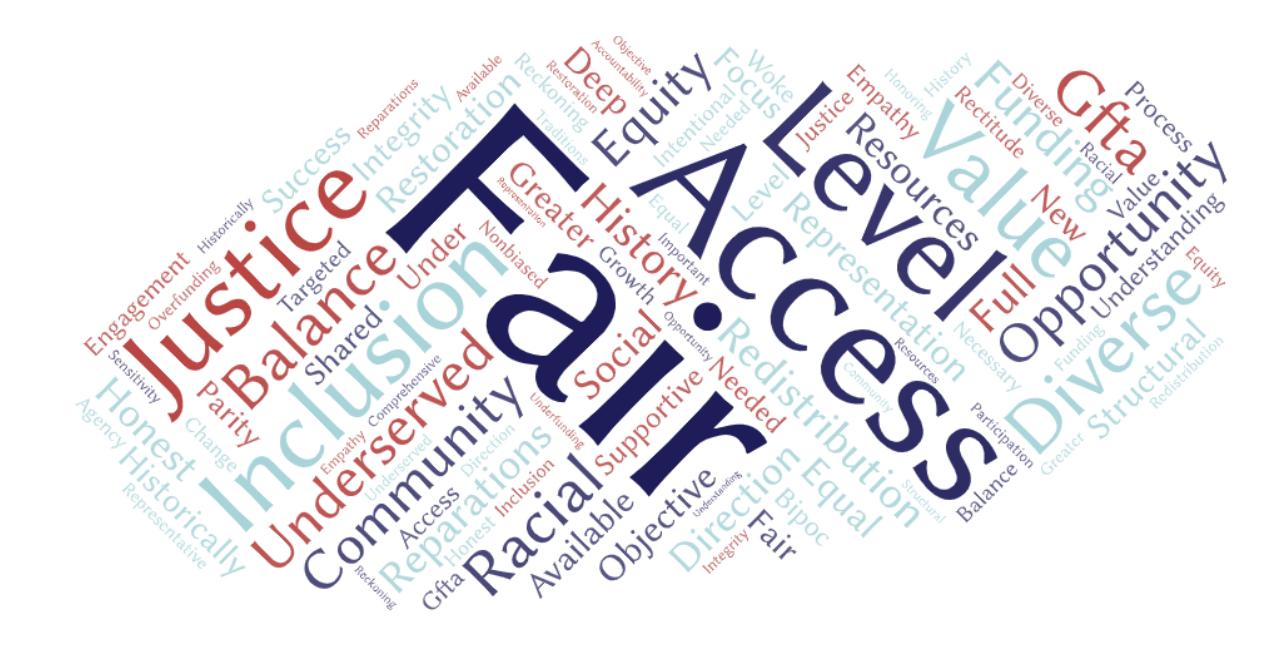
B. WORD CLOUD – VIBRANCY
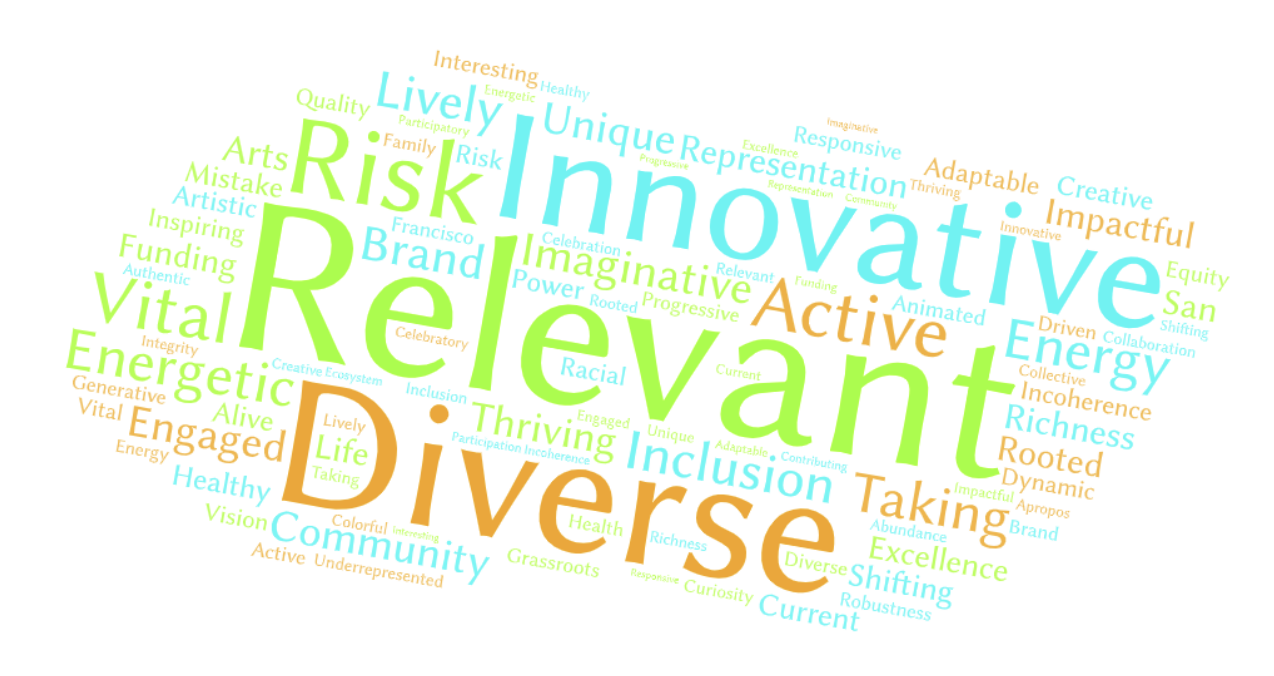
C. WORD CLOUD – ACCOUNTABILITY
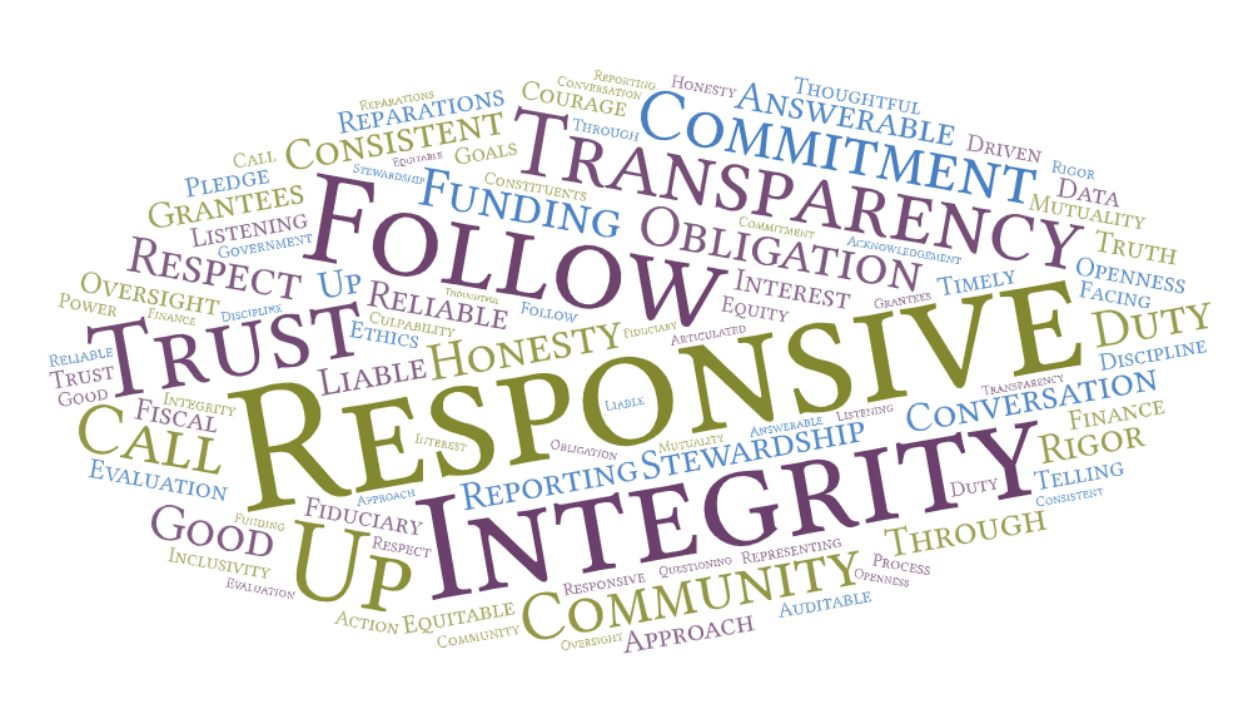
D. WORD CLOUD – TRANSPARENCY
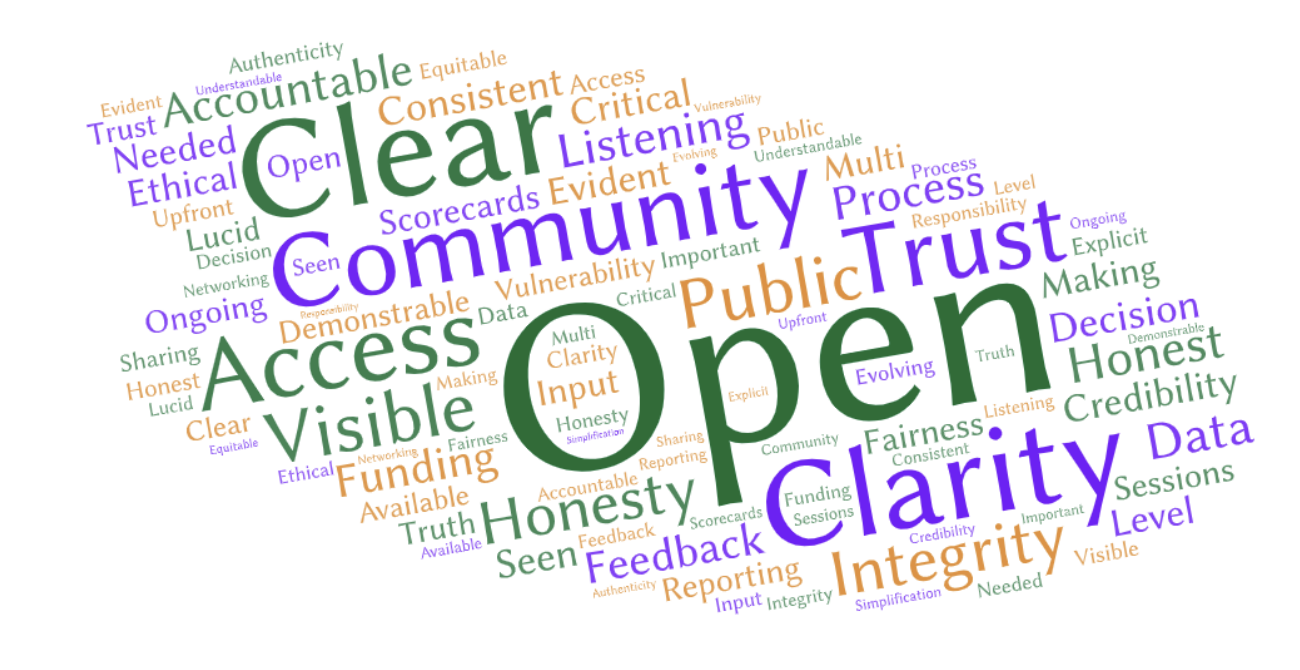
E. VISIONING WORK - FINAL VERSION
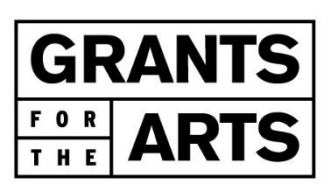
Mission, Vision, Values, Goals Overview
MISSION
At Grants for the Arts (GFTA), our mission is to promote the diverse and unique communities of San Francisco by supporting the arts through equitable grantmaking.
VISION
To uplift San Francisco nonprofit arts and cultural organizations in a manner that ensures equitable access to GFTA resources; to fully recognize their humanity and that of the communities they serve, exemplifying the value of their contributions to our city; to provide the opportunity to enrich and enhance the arts ecosystem of San Francisco to all; and to identify and eliminate barriers in our grantmaking, enabling arts organizations to prosper and reach their full potential.
VALUES
GFTA embraces EQUITY as our principal value.
EQUITY entails a commitment to ensuring GFTA’s grants and resources are accessible to all, understanding that certain communities have been historically overserved due to systemic advantages and access. Recognizing that arts organizations have not received equitable resources due to race, geography, and other marginalizing factors, GFTA endeavors to bolster culturally diverse and geographically-dispersed organizations by eliminating obstacles and shortfalls in grantmaking that have prevented the full participation, success, and stability of applicants and grantees.
In addition to EQUITY, three core values guide our work:
- VIBRANCY
- ACCOUNTABILITY
- TRANSPARENCY
VIBRANCY comprises the unique contributions grantee organizations bring to the arts landscape of San Francisco, steeped in the city’s values of diversity, inclusion, innovation, engagement, risktaking, and adaptability; evidenced by lively, imaginative programming, artistic cultivation, community relevance, a welcoming and safe atmosphere, preservation of marginalized spaces, local community and visitor interest and engagement, audience impact, demonstrable commitment to continued improvement, and management of artistic risk.
ACCOUNTABILITY requires holding both the agency and its grantees to the highest standard of integrity, ensuring that public funds are distributed and used in accordance with their intended purpose. It also requires GFTA to recognize our position of leadership in supporting the needs of the field, while adhering to the policies, procedures, and stakeholders of the City and County of San Francisco, with the understanding that community engagement is integral to our process.
TRANSPARENCY stems from cultivating a trust-based relationship between the agency and its stakeholders, which include City officials, Advisory Panel members, current grantees, future applicants, and the general public, with consistent, straightforward, and open communication regarding GFTA’s programs, policies, and procedures.
GOALS
GFTA’s work, procedures, and purpose will adhere to the values of EQUITY, VIBRANCY, ACCOUNTABLITY, and TRANSPARENCY in our grantmaking practices by:
- Committing to EQUITY in every aspect of our grantmaking, actively working to dismantle practices that have historically advantaged particular groups, and to more deeply support arts organizations within communities that have been harmed by a lack of access and resources;
- Enriching and promoting the VIBRANCY of San Francisco’s arts and cultural communities for the benefit of residents and visitors through equitable funding;
- Remaining ACCOUNTABLE to the needs of applicants and grantees through intentional, antiracist grantmaking and providing resources that will foster grantees’ accountability to their own communities; and
- Ensuring TRANSPARENCY through continued engagement, producing clearly defined grant programs and funding practices, making this information easily accessible to the public.
F. SAN FRANCISCO ARTS ECOSYSTEM NEEDS GRAPH
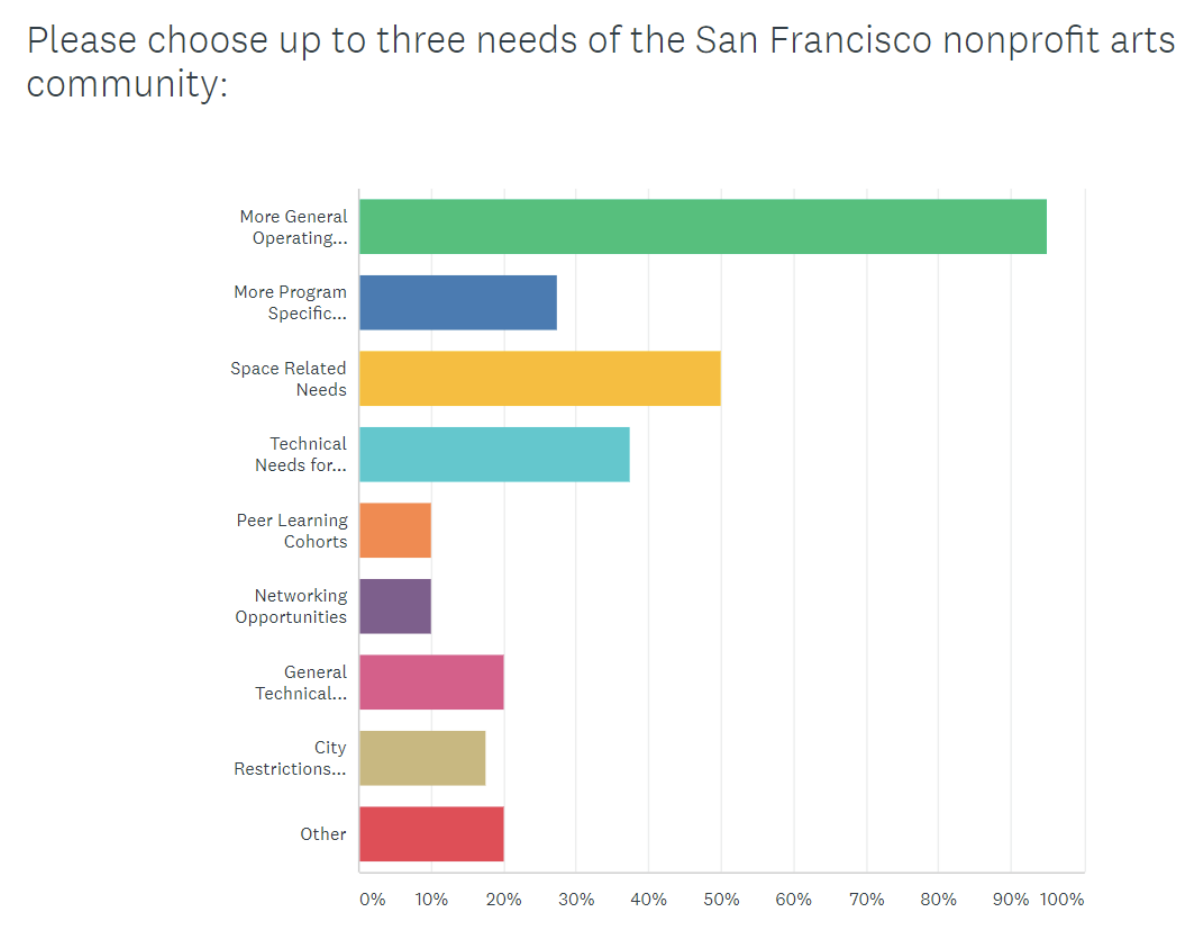
G. CONFIDENCE POLL
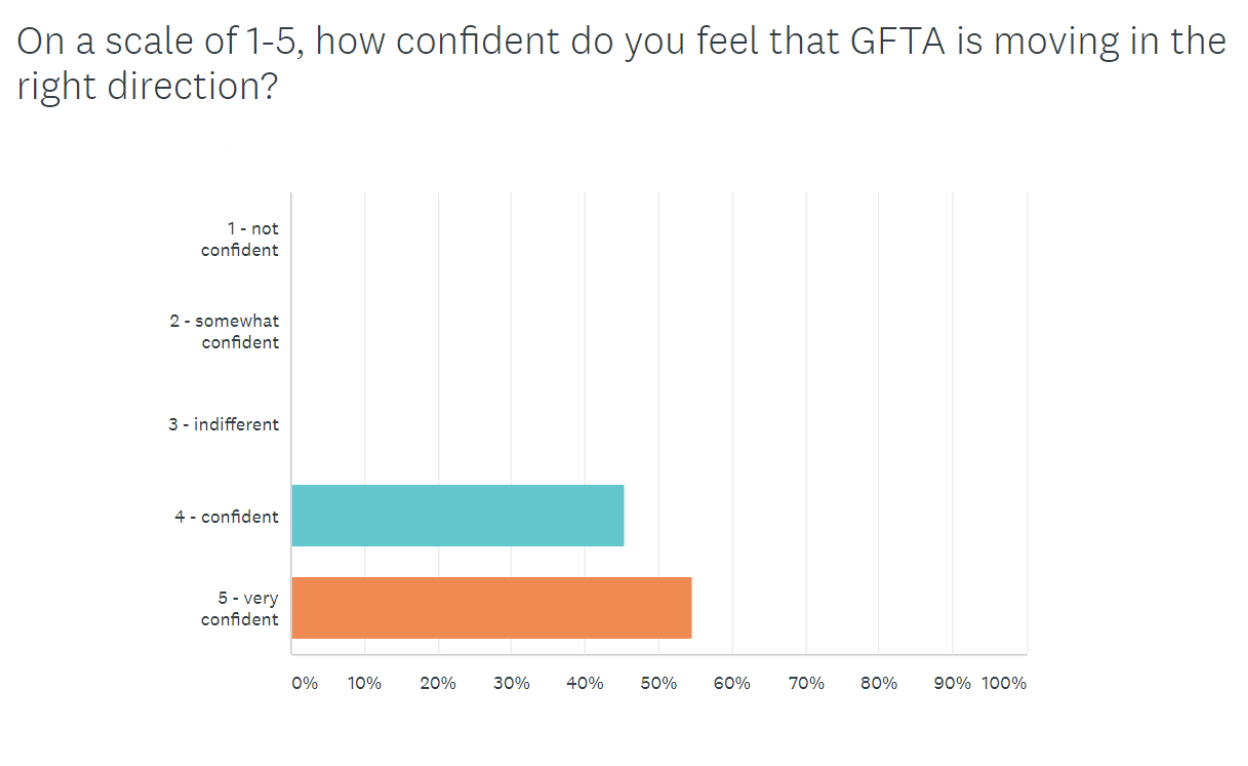
H. EFFECTIVENESS POLL
